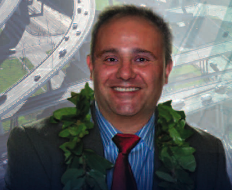See http://archives.starbulletin.com/2007/12/09/editorial/commentary4.html.
Ironically, the city's monthly propaganda on rail, paid by Honolulu taxpayers, May 2010 issue, pictures Oakland's Fruitvale Village TOD as a success. If success is noise and abandonment, then it is a success. This video proves it.
Many TOD as "automobile hate zones," their mobility is abysmally low and no small or large business can survive there unless it has its own (costly) parking.
Then there are these three fundamental points for the City Administration's and Dela Cruz’s enlightenment.
- TOD is Taxes Offered to Developers in multiple ways, (1) Upfront incentives which means taxes handed out to them as incentives, and (2) Reduced or waived property taxes for a number of years. Our city is in bad fiscal shape and in bad repair. Yet the typical politician proposes more taxes to benefit special interests but, as politicians do, they window dress taxes as a benefit for the "little guy."
- In January, 2009, The Urban Land Institute’s local chapter (ULI-Hawaii) commissioned a survey of housing attitudes among the public. The phone survey was of 600 Oahu residents. They are huge proponents of transit and smart growth, yet, among the conclusions is this: “there is relatively much less support for the smart growth idea of higher-density use of existing urban areas – perhaps in part because people here generally still would rather live in suburban/rural settings themselves.
- Portland, Oregon is the “poster child” of Light Rail advocacy and TODs. Research by Bruce Podobnik of the Department of Sociology at the Lewis and Clark College in Portland, Oregon dated July 15, 2009 concludes as follows:
“This study examines the extent to which specific social and environmental objectives have been achieved in the new urbanist community of Orenco Station (Portland, Oregon). House-level surveys were conducted in Orenco Station, as well as a traditional suburb and two long established urban neighborhoods.
“The analysis also reveals a higher level of walking, and an increase in the occasional use of mass transit, in the new urbanist community. However, the majority of residents in all four neighborhoods (including the new urbanist neighborhood) rely on single occupancy vehicles for their regular commute.”
So when it comes to rail-based Land Use for TODs and Smart Growth, the argument that these work is all political hot air. Buses and roadways can do much much better at a fraction of the cost to the public.
A great example of this is the total remake on Kapiolani Boulevard between McMully and South Street with the Convention Center, the doubling of Ala Moana Center, the Nauru Towers complex, multiple other residential towers, the large, elegant dealerships, etc.
What's the Kapiolani Boulevard lesson? Huge investment for development and redevelopment and much increased densities took place in the absence of rail. However, if Mayor Fasi’s rail was built along Kapiolani Boulevard in the early 1990s, then rail proponents would have credited all this billion dollar investment to rail.








